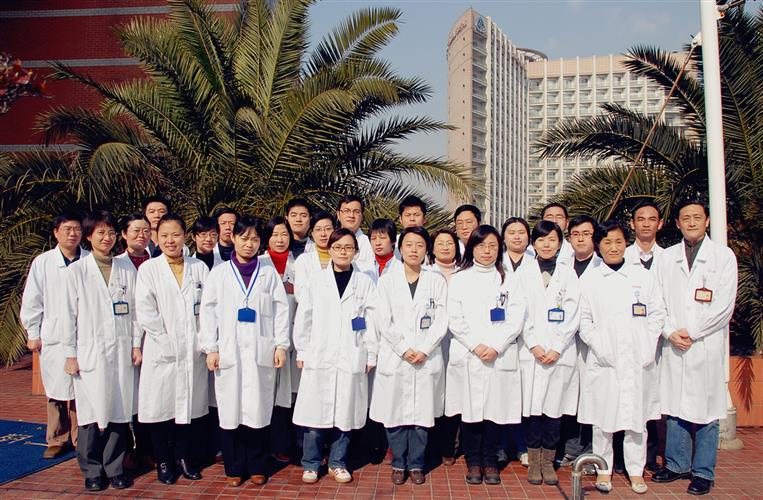The Department of Ultrasound of Zhongshan Hospital was founded in 1958. Tenure Prof. Xu Zhizhang, a well-known expert in medical ultrasonics in China, was its founder and first director. Under the leadership of Prof. Xu, the department made many pioneering achievements in history: we performed research on A-mode ultrasound diagnosis in 1958, applied manual-contact-type B-mode ultrasound tomographic diagnosis to clinical practice for the first time in 1960, took the lead in developing M-mode ultrasound cardiograph in 1961, developed a contrast media made of ascorbic acid plus sodium bicarbonate for the first time in China and applied to clinical practice in 1978, and were the first to investigate interventional ultrasound techniques in 1984, all of which have made great contribution to the development of ultrasonic medicine in China. The present director is Prof. Wang Wenping, and the vice directors are Huang Beijian and Ding Hong, both of them are chief physicians. Prof. Xu Zhizhang served as the chairman of Institute of Ultrasonic Medicine, Chinese Medical Association and Prof. Wang Wenping now serves as its vice chairman. Many staff in the department serve as committee members or members of the standing committee in national and local specialized institutes. Shanghai Ultrasound Quality Control Center (founded in 2000) and Ultrasonic Medicine and Engineering Research Institute of Fudan University (founded in 2003) are both affiliated to Zhongshan Hospital.
Under the leadership of academic leaders, the department constantly improves the quality of the staff, clinic practice, and scientific research on three subspecialties: abdomen ultrasound, vascular ultrasound, and superficial part ultrasound. The subspecialties are respectively led by 3 academic leaders to carry out clinical practice and scientific research and have formed a mature and complete discipline team consisted of elderly, middle-aged, and young staff. Currently the department has over 30 physicians, 3 technicians, and 2 nurse practitioners. Among them, 34% have a senior professional title, 80% have an intermediate or above professional title, 80% have a graduate degree with 6 doctoral graduates and 4 on-job doctoral candidates. The department now has about 30 consulting rooms, including color ultrasonic rooms for inpatients, color ultrasonic rooms for outpatients, and interventional ultrasound rooms, etc. There are altogether nearly 40 ultrasonographic equipments with 1 microwave ablation equipment and 1 laser ablation equipment. Every year, we serve over 200,000 patients using color ultrasound and perform over 3,500 various interventional operations. With over half a century’s development, the department, starting from scratch, has turned from a weak specialty to a strong one and developed from a diagnostic department to an integrated one of both diagnosis and treatment. It has created many pioneering achievements with its leading medical and scientific research level in China. It has now developed into a well-equipped department with high quality diagnosis and treatment and earns a high reputation.

Zhongshan Hospital affiliated to Fudan University is a national diagnosis and treatment center for difficult diseases. Its treatment and research of liver tumors have reached the world level. The department cooperates closely with Department of Liver Neoplasm Surgery and Internal Medicine Department of Liver Neoplasm and other clinical departments. Since we developed ultrasonic contrast for liver for the first time in 1992, the colleagues in the department have made unremitting endeavors for over 20 years, and now we play a decisive role in the diagnosis and treatment of focal liver lesions, especially small hepatocellular carcinoma. In recent years, we have been exploring and developing new techniques, such as ultrasonic contrast, image fusion for surgical navigation and elasticity imaging, etc., reaching the leading level in China in the diagnosis of liver neoplasm. We also apply the new techniques such as ultrasound contrast to the diagnosis of diseases of many other organs, including kidney, thyroid, mammary gland and blood vessel. These applications prove to be effective and improve the diagnosis level of these organ diseases and thousands of patients are diagnosed by ultrasound contrast every year. As early as in 1992, we have already used partial injection of anhydrous alcohol to treat liver cancer, and we started to treat liver cancer using microwave ablation in 2002. Therefore, we have accumulated rich experiences in the local treatment of liver neoplasm.
The department has always put great emphasis on teaching and boasts a group of excellent teachers, including 2 doctoral supervisors and 5 master supervisors. It undertakes multiple teaching tasks, including teaching postgraduates of eight-year and seven-year programs, students from the image base, undergraduates and visiting students. In the last 5 years, the department has cultivated 8 doctoral students, more than 20 master students, among whom most were awarded as outstanding graduates of Shanghai or Fudan University. After graduation, they work in hospitals of different levels all over the country and become the medical backbones in their own professional fields. The department organizes classes on new ultrasound technology at a national level three times every year with 150 students participating annually.
Under the leadership of academic leaders and backbones of the specialty, the department has completed many scientific research projects at national and provincial levels. In the last 5 years, it has undertaken 15 projects from Natural Science Foundation of China, Science and Technology Commission of Shanghai Municipality, and Shanghai Municipal Commission of Health and Family Planning. The scientific research findings won the first and third prizes of Shanghai Science and Technology Progress Award in 2011 and 2004 respectively. In the last 5 years, the department has published over 160 papers including over 50 SCI papers, compiled over 10 books, and translated 1 book as the chief translator. Many staff of the department serve as the editorial board members of top journals and magazines of China.



